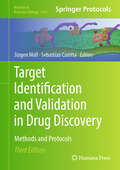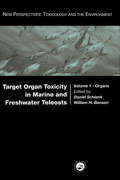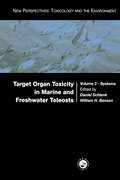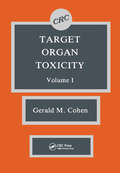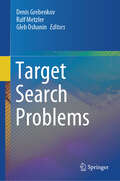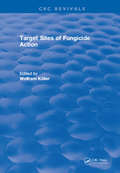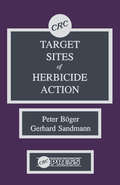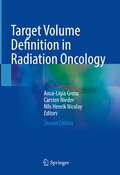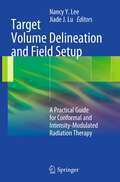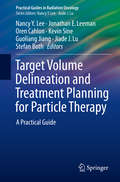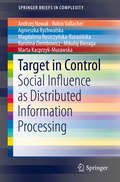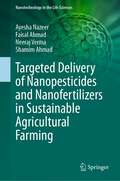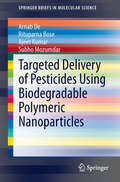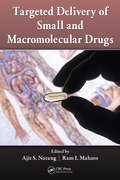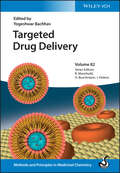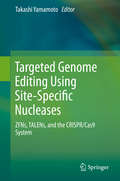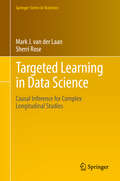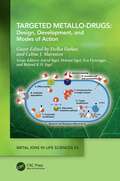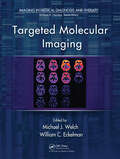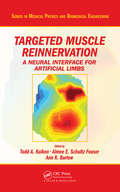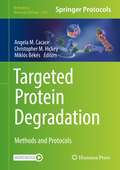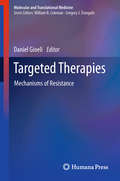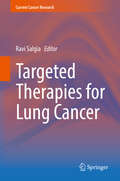- Table View
- List View
Target Identification and Validation in Drug Discovery: Methods and Protocols (Methods in Molecular Biology #2905)
by Jürgen Moll Sebastian CarottaThis third edition book explores breakthrough techniques in the field of drug target identification and validation. With technologies and methodologies ranging from target identification to the analysis of clinical samples, as well as newer areas like artificial intelligence and machine learning applications, the book will aid decision-makers in drug development by offering a succinct overview of the available technologies for portfolio management. Written for the highly successful Methods in Molecular Biology series, chapters include introductions to their respective topics, lists of the necessary materials and reagents, step-by-step and readily reproducible laboratory protocols, and tips on troubleshooting and avoiding known pitfalls. Authoritative and up-to-date, Target Identification and Validation in Drug Discovery: Methods and Protocols, Third Edition will help a diverse audience of scientists find valuable insights to address their drug development inquiries.
Target Organ Toxicity in Marine and Freshwater Teleosts: Organs (New Perspectives: Toxicology and the Environment)
by Daniel Schlenk, William H. BensonAddressing the numerous gaps in current information, Target Organ Toxicology in Marine and Freshwater Teleosts is an essential resource for researchers and professionals in aquatic toxicology and environmental risk assessment. All the chapters are written by researchers who are internationally recognised for their work in mechanistic aspects of aquatic toxicology. Each chapter focuses on a specific target organ or physiological system and describes how various agents disrupt the normal physiological system and processes. This volume is devoted to specific organs with coverage of the gill, kidney, skin, liver and gut. The companion volume, Systems, provides coverage of toxic effects in the central nervous, immune, neurobehavioural and reproductive systems as well as describing general mechanisms of toxicity.
Target Organ Toxicity in Marine and Freshwater Teleosts: Systems (New Perspectives: Toxicology and the Environment)
by William H. Benson Daniel SchlenkAddressing the numerous gaps in current information, Target Organ Toxicology in Marine and Freshwater Teleosts is an essential resource for researchers and professionals in aquatic toxicology and environmental risk assessment.All the chapters are written by researchers who are internationally recognised for their work in mechanistic aspects of
Target Organ Toxicity, Volume I: Volume 2 (Routledge Revivals Ser.)
by Gerald M. CohenThis two-volume set provides essential information on the general princi-ples of target organ toxicity. Pharmacokinetics, metabolic activation and key defense mechanisms, excretion, species variation, and tissue-specific biochemistry are explored comprehensively. These general principles are then illustrated using specific examples of toxicity to different target organs and systems. DNA modifi-cation and repair in tumor induction, and specificity in tumor initiation are also examined. Of primary interest to toxicologist, pharma-cologists, biochemists, and environmental toxicologists.
Target Organ Toxicology in Caenorhabditis elegans
by Dayong WangThis book introduces readers to intestinal and epidermal barriers, and to toxicity induction of environmental toxicants or stresses in the intestine, epidermis, neurons, muscle, and reproductive organs in Caenorhabditis elegans. In addition, it discusses the protective responses of various organs and nematodes’ avoidance behaviour with regard to environmental toxicants or stresses. The intestinal, epidermal, neuronal, and germline signalling pathways required for the regulation of toxicity of environmental toxicants or stresses are also introduced and discussed. As a classic model animal with well-described genetic and developmental backgrounds, the nematode Caenorhabditis elegans has been successfully and widely used in both toxicity assessments and toxicological studies on various environmental toxicants and stresses. Once exposure to certain environmental toxicants has occurred, the toxicants can enter into the primary targeted organs (such as intestinal cells), and even be translocated into secondary targeted organs (such as reproductive organs and neurons). Based on related available data, this book provides a systematic understanding of target organ toxicology in C. elegans.
Target Search Problems
by Denis Grebenkov Ralf Metzler Gleb OshaninThis book presents cutting-edge research addressing the mathematical models used to tackle the "Target problem" as it manifests itself in a wide range of disciplines. Leading international experts from around the world describe a variety of different approaches to this truly multidisciplinary topic. Recent years have witnessed a substantial and still growing interest in understanding the general "Target problem". This encompasses a wide range of different situations in which some "agents" perform a deterministic or stochastic motion to search for a certain immobile or mobile "target". Such problems arise in many disciplines: to name but a few, computer science, the evolution of stock markets, biochemistry, bio-medicine, evolutionary games, as well as diverse areas of physics. This book with its up-to-date collection of chapters authored by leading experts in these and other fields, provides a comprehensive and complete picture in broadlyaccessible language. The book will naturally serve as a source of inspiration for further research, as well as facilitating a cross-fertilization of approaches, ideas, and research directions.
Target Sites of Fungicide Action
by Wolfram KoellerTarget Sites of Fungicide Action presents a critical examination of the mode of action of antifungal inhibitors, especially the mechanistical aspects of agricultural fungicides and antifungal drugs. It provides an interdisciplinary approach through its discussions of inhibitors with target sites in sterol biosynthesis, molecular studies in fungicide research, and fungal resistance. Researchers and students in plant pathology, mycology, and medicine will find this book to be a comprehensive summary of current knowledge, as well as a source of stimulation for future research in the field of applied mycology.
Target Sites of Herbicide Action
by Peter Boger Gerhard SandmannThis publication is based on the plant processes and reaction sites for which reliable knowledge on both their physiology and biochem-istry and the mode of herbicidal action is available. Targets of the agrochemical research, such as enzymes of biosynthetic pathways or herbicide-binding peptides in the photosynthetic membrane, are highlighted. Detailed knowledge about the target sites will allow bio-chemical model systems to evaluate the biological activity of newly synthesized compounds before their conventional screening in the greenhouse. Quantitative structure/activity relationships should be performed more reliably with simple biological species or enzymol-ogy assays, to aid in the rational design of pesticides. This text is highly valuable for plant physiologists, pathologists, and chemists in the agrochemical industry and universities.
Target Volume Definition in Radiation Oncology
by Carsten Nieder Anca-Ligia Grosu Nils Henrik NicolayThis updated edition of the book provides radiation oncologists with a structured, state-of-the-art guide to target volume delineation for all major cancer types. It provides an overview of recent advances in radiation treatment techniques and multimodal imaging for radiation treatment planning. It also offers clear and structured guidelines for the contouring of target volumes and organs at risk, taking into account the available imaging modalities including PET/CT and multiparametric MR imaging. Each chapter addresses the target volume concepts of a particular tumor type and has been written by experts in the field. Covering all major tumor entities, the book provides practicing radiation oncologists with a guide to defining target volumes based on multimodal imaging.
Target Volume Delineation and Field Setup
by Jiade J. Lu Nancy Y. LeeThis handbook will enable radiation oncologists to appropriately and confidently select and delineate tumor volumes/fields for conformal radiation therapy, including intensity-modulated radiation therapy (IMRT), in patients with commonly encountered cancers. The orientation of this handbook is entirely practical, in that the focus is on the illustration of clinical target volume (CTV) delineation for each major malignancy. Each chapter provides guidelines and concise knowledge on treatment planning and CTV selection, explains how the anatomy of lymphatic drainage shapes target volume selection, and presents detailed illustrations of delineations, slice by slice, on planning CT images. While the emphasis is on target volume delineation for three-dimensional conformal therapy and IMRT, information is also provided on conventional radiation therapy field setup and planning for certain malignancies for which IMRT is not currently suitable.
Target Volume Delineation and Treatment Planning for Particle Therapy
by Jiade J. Lu Nancy Y. Lee Jonathan E. Leeman Oren Cahlon Kevin Sine Guoliang Jiang Stefan BothThis handbook is designed to enable radiation oncologists to treat patients appropriately and confidently by means of particle therapy. The orientation and purpose are entirely practical, in that the focus is on the physics essentials of delivery and treatment planning , illustration of the clinical target volume (CTV) and associated treatment planning for each major malignancy when using particle therapy, proton therapy in particular. Disease-specific chapters provide guidelines and concise knowledge on CTV selection and delineation and identify aspects that require the exercise of caution during treatment planning. The treatment planning techniques unique to proton therapy for each disease site are clearly described, covering beam orientation, matching/patching field techniques, robustness planning, robustness plan evaluation, etc. The published data on the use of particle therapy for a given disease site are also concisely reported. In addition to fully meeting the needs of radiation oncologists, this "know why" and "know how" guide to particle therapy will be valuable for medical physicists, dosimetrists, and radiation therapists.
Target in Control: Social Influence as Distributed Information Processing (SpringerBriefs in Complexity)
by Robin R. Vallacher Agnieszka Rychwalska Magdalena Roszczyńska-Kurasińska Karolina Ziembowicz Marta Kacprzyk-Murawska Andrzej K. Nowak Mikolaj BiesagaThis concise monograph introduces and examines social influence from the perspective of the so-called target, rather than from the source, thus providing for the first time a bidirectional account of this pervasive social phenomenon, further bridging simple micro-level dyadic interaction rules with macro-level properties of the (social) system. This integrative approach allows for advanced models of influence to be developed in both the social and natural sciences (e.g. social animals). In particular, when used to investigate emergent properties of social change, this approach shows that social transitions occur as “bubbles of new” in the “sea of old.” While in the traditional view influence is synonymous with achieving power and control over others, the present approach to social influence puts the emphasis on the target’s motives and strategies. Here, the target may actively seek out influence to help forge opinions and achieve guidance regarding courses of action. In this process, the target observes others, models their thought and behavior, and asks for information and opinions. In this broadened perspective, the processes of social influence enables those being influenced (the targets) to use the knowledge and processing capacity of influence sources to maximize their access to information, minimize their processing effort, while optimizing their own functioning and that of the social system in which they evolve. This short text addresses above all scientists interested in social influence in the fields of psychology, sociology, economy, marketing, and biology. However, also researchers interested in modeling social processes, especially opinion dynamics and social change, such as computer scientists, physicists and applied mathematicians will benefit from the insights provided.
Targeted Cancer Therapy in Biomedical Engineering (Biological and Medical Physics, Biomedical Engineering)
by Rishabha Malviya Sonali SundramThis book highlights the role of Biomedical Engineering (BME) used in diagnosis (e.g., body scanners) and treatment (radiation therapy and minimal access surgery in order to prevent various diseases). In recent years, an important progress has been made in the expansion of biomedical microdevices which has a major role in diagnosis and therapy of cancer. When fighting cancer, efficacy and speed are of the utmost importance. A recently developed microfluidic chip has enabled a breakthrough in testing the efficacy of specialized cancer drugs.Effective cancer-targeting therapies will require both passive and active targeting strategies and a thorough understanding of physiologic barriers to targeted drug delivery. Targeted cancer treatments in development and the new combinatorial approaches show promise for improving targeted anticancer drug delivery and improving treatment outcomes.This book discusses the advancements and innovations in the field of BME that improve the diagnosis and treatment of cancer. This book is focused on bioengineering approaches to improve targeted delivery for cancer therapeutics, which include particles, targeting moieties, and stimuli-responsive drug release mechanisms. This book is a useful resource for students, researchers, and professionals in BME and medicine.
Targeted Delivery of Nanopesticides and Nanofertilizers in Sustainable Agricultural Farming (Nanotechnology in the Life Sciences)
by Ayesha Nazeer Faisal Ahmad Neeraj Verma Shamin AhmadNanofertilizers and nanopesticides increase crop efficiency because of a several-fold increase in the surface-to-volume ratio of nano-forms of nutrients and their suitability to foliar application. The potential agricultural benefits of these nanomaterials, their modes of action, and the fate of nanomaterials in the soil are all discussed. This book uses a multidisciplinary approach and highlights the expertise of the authors in the fields of materials science, nanotechnology, nanobiosensors, and agricultural research. It describes the details of nanoscale synthesis of materials for targeted delivery; in vitro, in vivo, and field trials experimentation; how to use digital technology for specific solutions including Big Data to create predictive mathematical modelling; along with the core knowledge of plant systems and their biosphere to improve crop yields. Also, the book discusses future perspectives and challenges of nanomaterials in agricultural applications. In summary, this book discusses agricultural nanobiotechnology with its main emphasis on understanding the interactions of nanoscale materials of pesticides and fertilizers. It also covers their application to improve the quality and increase crop yield with a minimum use of the active ingredients attached to the nanocarriers.
Targeted Delivery of Pesticides Using Biodegradable Polymeric Nanoparticles
by Arnab De Rituparna Bose Ajeet Kumar Subho MozumdarThe brief is the first to focus exclusively on environmentally friendly delivery of pesticides (controlled-release nanoparticulate formulation of pesticides using biodegradable polymers as carriers). The brief also introduces pesticides like Chlorpyrifos and biodegradable polymers like guar-gum. The brief will be extremely useful to the researchers in the field of agrochemicals and will be equally useful for advanced professionals in the field of biology, chemistry, environmental biology, entomology and horticulture.
Targeted Delivery of Small and Macromolecular Drugs
by Ram I. Mahato Ajit S. NarangSite-specific drug delivery and targeting attracts much research interest from both academia and industry, but because of the many challenges faced in the development of these systems, only a handful of targeted therapies have successfully made it into clinical practice. Focusing on the delivery technologies that utilize both systemic and local rou
Targeted Drug Delivery (Methods & Principles in Medicinal Chemistry)
by Raimund Mannhold Jörg Holenz Helmut BuschmannTargeted Drug Delivery Novel approaches in targeted drug delivery for both small molecule and biopharmaceutical drugs Targeted Drug Delivery explores a new frontier in drug research that has become a focus for developing novel medications. The work discusses a wide range of approaches for targeting small molecules as well as peptide and macromolecular drugs, from prodrugs to drug conjugates to drug carriers and devices, helping readers to stay up to date on the latest developments in the field. The following key topics are addressed: Antibody conjugates, prodrugs, and suicide gene therapeutics Protac technology for selectively degrading target proteins Delivery of nucleic acid drugs Novel drug carriers, such as liposomes, vesicles, and nanoparticles Unmet medical needs for which there is a large market potential, such as viral infections and cancer For chemists, pharmacologists, and professionals in the wider pharmaceutical industry, Targeted Drug Delivery is a comprehensive guide on how to solve the greatest challenge in treating many diseases: delivering a pharmaceutically active substance to the target tissue in the body.
Targeted Genome Editing Using Site-Specific Nucleases
by Takashi YamamotoThis book serves as an introduction to targeted genome editing, beginning with the background of this rapidly developing field and methods for generation of engineered nucleases. Applications of genome editing tools are then described in detail, in iPS cells and diverse organisms such as mice, rats, marine invertebrates, fish, frogs, and plants. Tools that are mentioned include zinc finger nucleases (ZFNs), transcription activator-like effector nucleases (TALENs), and CRISPR/Cas9, all of which have received much attention in recent years as breakthrough technologies. Genome editing with engineered nucleases allows us to precisely change the target genome of living cells and is a powerful way to control functional genes. It is feasible in almost all organisms ranging from bacteria to plants and animals, as well as in cultured cells such as ES and iPS cells. Various genome modifications have proven successful, including gene knockout and knock-in experiments with targeting vectors and chromosomal editing. Genome editing technologies hold great promise for the future, for example in biomedical research, clinical medicine, and generation of crops and livestock with desirable traits. A wide range of readers will find this book interesting, and with its focus on applications in a variety of organisms and cells, the book will be valuable for life scientists in all fields.
Targeted Learning in Data Science: Causal Inference For Complex Longitudinal Studies (Springer Series in Statistics)
by Mark J. van der Laan Sherri RoseThis textbook for graduate students in statistics, data science, and public health deals with the practical challenges that come with big, complex, and dynamic data. It presents a scientific roadmap to translate real-world data science applications into formal statistical estimation problems by using the general template of targeted maximum likelihood estimators. These targeted machine learning algorithms estimate quantities of interest while still providing valid inference. Targeted learning methods within data science area critical component for solving scientific problems in the modern age. The techniques can answer complex questions including optimal rules for assigning treatment based on longitudinal data with time-dependent confounding, as well as other estimands in dependent data structures, such as networks. Included in Targeted Learning in Data Science are demonstrations with soft ware packages and real data sets that present a case that targeted learning is crucial for the next generation of statisticians and data scientists. Th is book is a sequel to the first textbook on machine learning for causal inference, Targeted Learning, published in 2011.Mark van der Laan, PhD, is Jiann-Ping Hsu/Karl E. Peace Professor of Biostatistics and Statistics at UC Berkeley. His research interests include statistical methods in genomics, survival analysis, censored data, machine learning, semiparametric models, causal inference, and targeted learning. Dr. van der Laan received the 2004 Mortimer Spiegelman Award, the 2005 Van Dantzig Award, the 2005 COPSS Snedecor Award, the 2005 COPSS Presidential Award, and has graduated over 40 PhD students in biostatistics and statistics.Sherri Rose, PhD, is Associate Professor of Health Care Policy (Biostatistics) at Harvard Medical School. Her work is centered on developing and integrating innovative statistical approaches to advance human health. Dr. Rose’s methodological research focuses on nonparametric machine learning for causal inference and prediction. She co-leads the Health Policy Data Science Lab and currently serves as an associate editor for the Journal of the American Statistical Association and Biostatistics.
Targeted Metallo-Drugs: Design, Development, and Modes of Action (Metal Ions in Life Sciences Series)
by Astrid Sigel Helmut Sigel Roland K. O. Sigel Eva Freisinger Etelka Farkas Celine J. MarmionVolume 24, entitled Targeted Metallo-Drugs: Design, Development, and Modes of Action, of the series Metal Ions in Life Sciences (MILS), fosters inter-disciplinary research in the vibrant field of Biological Inorganic Chemistry. Inspired by the clinical success of cisplatin as a leading anticancer drug but mindful of the shortcomings associated with its use including dose-limiting toxic side effects and acquired or intrinsic drug resistance, scientists across the globe have been endeavoring to identify new metallo-drugs for therapeutic exploitation. This has led to innovative metallo-drug candidates that (i) enhance cancer cell selectivity, thus reducing toxic side effects, and/or (ii) possess new modes of action to improve efficacy and also target resistance pathways. This and more are captured in MILS- 24 which consists of 12 comprehensive, well-illustrated, and up to date chapters with over 1600 citations, 100 figures, and 10 tables with key contributions from 32 international experts from Europe, Asia, and North and South America. MILS- 24 not only keeps the scientific community abreast of latest developments, it also serves as an invaluable resource to stimulate further research on targeted metallo-drug design and development. • It covers anticancer, antimicrobial, antiviral, and other agents, such as those targeting tropical diseases and cyanide poisoning and radiometals in molecular imaging and therapy. • It highlights recent metallo-drug developments targeting COVID-19. • It features advanced spectroscopic methods and metallomics as important tools to elucidate the modes of actions of metallo-drugs.
Targeted Molecular Imaging (Imaging in Medical Diagnosis and Therapy)
by William C. Eckelman Michael J. WelchTargeted Molecular Imaging covers the development of novel diagnostic approaches that use an imaging probe and agent to noninvasively visualize cellular processes in normal and disease states. It discusses the concept, development, preclinical studies, and, in many cases, translation to the clinic of targeted imaging agents. The many case studies t
Targeted Muscle Reinnervation: A Neural Interface for Artificial Limbs (Series in Medical Physics and Biomedical Engineering)
by Todd A. Kuiken Aimee E. Schultz Feuser Ann K. BarlowImplement TMR with Your Patients and Improve Their Quality of LifeDeveloped by Dr. Todd A. Kuiken and Dr. Gregory A. Dumanian, targeted muscle reinnervation (TMR) is a new approach to accessing motor control signals from peripheral nerves after amputation and providing sensory feedback to prosthesis users. This practical approach has many advantage
Targeted Protein Degradation: Methods and Protocols (Methods in Molecular Biology #2365)
by Angela M. Cacace Christopher M. Hickey Miklós BékésThis volume contains a collection of innovative techniques for studying targeted protein degradation. Chapters guide readers through heterobifunctional proteolysis-targeting chimeras (PROTACs) approaches, E3 ligase, E3 ligase-induced ubiquitylation, proteomic approaches, novel degrader molecules, molecular glue, and stabilize binding interaction between a target and E3 ubiquitin ligase. Written in the format of the highly successful Methods in Molecular Biology series, each chapter includes an introduction to the topic, lists necessary materials and reagents, includes tips on troubleshooting and known pitfalls, and step-by-step, readily reproducible protocols. Authoritative and cutting-edge, Targeted Protein Degradation: Methods and Protocols aims to ensure successful results in this emerging field of drug discovery.
Targeted Therapies
by Daniel GioeliThis volume explores the mechanisms of resistance to targeted therapeutics. The focus is on the cancer cell signaling network, although other mechanisms of resistance including target mutation, and new areas of study such as cancer stem cells are included. Targeted Therapies: Mechanisms of Resistance highlights examples of changes in the signaling network in response to inhibition of a signaling event and underscores the importance in having a mechanistic understanding of the signaling network in cancer for developing effective targeted cancer therapies. Moreover, cutting edge tools to analyze the cell signaling network will be discussed. This includes the leading edge of techniques as well as computational biology and systems theory. This volume provides the reader with both an overview as well as a detailed perspective on the mechanisms of resistance to targeted therapeutics and will be of great value to the oncologist, the physician-scientist treating patients and the translational scientist working on any aspect of targeted therapeutics.
Targeted Therapies for Lung Cancer (Current Cancer Research)
by Ravi SalgiaThis book contextualizes translational research and provides an up to date progress report on therapies that are currently being targeted in lung cancer. It is now well established that there is tremendous heterogeneity among cancer cells both at the inter- and intra-tumoral level. Further, a growing body of work highlights the importance of targeted therapies and personalized medicine in treating cancer patients. In contrast to conventional therapies that are typically administered to the average patient regardless of the patient’s genotype, targeted therapies are tailored to patients with specific traits. Nonetheless, such genetic changes can be disease-specific and/or target specific; thus, the book addresses these issues manifested in the somatically acquired genetic changes of the targeted gene. Each chapter is written by a leading medical oncologist who specializes in thoracic oncology and is devoted to a particular target in a specific indication. Contributors provide an in-depth review of the literature covering the mechanisms underlying signaling, potential cross talk between the target and downstream signaling, and potential emergence of drug resistance.
